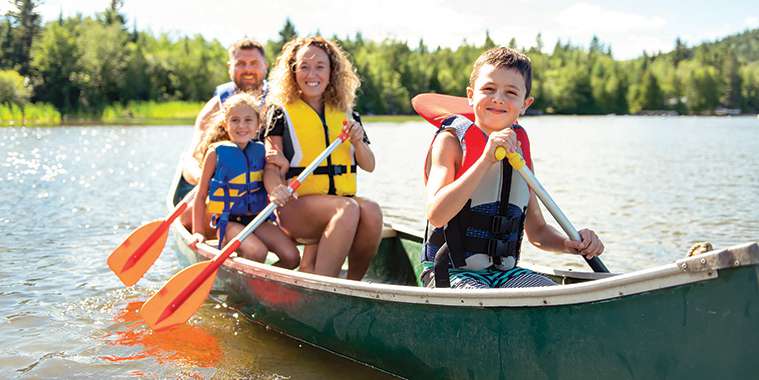May 19 is National Lifejacket Day. If there’s one thing Manitobans love about summer, it’s cottage season, recreational boating, fishing and the beach. Even if you don’t leave the city, it’s possible to enjoy some form of water activity either beside — if you’re fishing, for example — or on one of our many rivers.
There is only one way to do this safely. Wear a flotation device. Never underestimate how much protection a flotation device can give you. It’s called lifesaving equipment for a reason. It won’t work if you don’t wear it. In almost 90% of fatal boating incidents in Canada, the victims were not wearing flotation devices, or were not wearing them correctly. Drowning is the third leading cause of death in Canada (after auto accidents and accidental poisoning). You are required by law to have a lifejacket or personal flotation device on board for each person on a watercraft. This includes human-powered craft.
There are two different types of flotation devices: lifejackets and personal flotation devices (PFD). You may have thought they were the same, but there are key differences between the two. The type of activity that you’re going to be taking part in, the type of comfort and fit you want, the amount of thermal protection and bouyancy all come into play when choosing which is best. Here’s a rundown on both types.
Lifejackets
A lifejacket is your best defence against cold-water shock. Research shows that unexpected immersion in cold water is a serious risk to life if a boater is not wearing a flotation device due to the gasp reflex. This is true despite the boater’s experience, closeness to shore, and even swimming ability.
A sudden fall into cold water can seriously affect breathing, nerves, and muscle strength. A lifejacket gives you thermal protection as well as keeping you buoyant. Lifejackets provide more flotation in water than most PFDs. Lifejackets come only in red, orange, and yellow so you are more visible while in the water.
There are three Canadian-approved types:
1. Safety of Life at Sea (SOLAS) lifejackets meet very high performance standards and are approved for all vessels. They offer these key features:
• will turn you on your back in seconds to keep your face out of the water, even if you are unconscious;
• come in two sizes — over 32 kg (70 lbs.) or less than 32 kg;
• are available in comfortable and compact inflatable styles that can be automatically, manually or orally inflated.
2. Standard Type lifejackets are approved for all vessels, except SOLAS vessels. They:
• will turn you on your back to keep your face out of the water, even if you are unconscious;
• come in two sizes — over 40 kg (88 lbs.) or less than 40 kg.
3. Small Vessel lifejackets are approved for small vessels. They:
• have less flotation than Standard Type lifejackets;
• turn you on your back, but may do so more slowly;
• come in two models — keyhole and vest;
• come in three sizes.
Personal Flotation Devices (PFD)
A personal flotation device (PFD) comes in many types, sizes, and colours. Not all are red, orange, or yellow, but it is a good idea to choose these colours to be more visible when in the water.
Choose a PFD based on your needs and your activity. If you are operating at high speeds, look for a PFD with three or more chest belts for security. If you are operating in cold water (less than 15°C), choose a PFD with thermal protection.
There are pros and cons to choosing a PFD over a lifejacket. A PFD:
• may be more comfortable because it is designed for constant wear;
• is lighter, less bulky, and may be designed for specific sport activities;
• usually offers less flotation than a lifejacket;
• has limited capability to turn you in the water
• often offers less thermal protection than a lifejacket;
• if inflatable, must be used and maintained correctly in order to work.
If you choose an inflatable PFD, check which boating activities they are approved for under the Small Vessel Regulations. Inflatable PFDs are prohibited for:
• people who are under 16 years of age, or who weigh under 36.3 kg (80 lbs.);
• operators of personal watercraft.
Inflatable PFDs come in two styles:
• Vest types inflate automatically, or are inflated orally or manually with a CO2 system.
• Pouch types can be orally inflated, or manually inflated by pulling a toggle to activate CO2 inflation.
The inflation time is relatively short but still could be difficult for a weak swimmer. All Canadian-approved inflatable PFDs have an oral inflation tube in case the CO2 inflation mechanism fails. If you are struggling to stay afloat, using this tube could be challenging.
An emergency is no time to experiment with a new device. Read your manual for the PFD carefully. Under supervision and before heading out, try the device on and make sure you know how to use it.
Keeping children afloat
A lifejacket or PFD is no substitute for adult supervision. Children should be within arm’s reach as well as wearing a proper flotation device at all times.
Buy only Canadian-approved devices. Have your child try on the device before you buy it.
• It should fit snugly and not ride up over your child’s chin or ears.
• There should be less than 7.6 cm (3”) between your child’s shoulders and the device. Otherwise, the device is too big and could do more harm than good.
Look for these safety features:
• a large collar for head support
• waist ties or elastic gathers in front and back
• a safety strap that goes between the legs to prevent the device from slipping over your child’s head
• buckles on safety straps and reflective tape,
Consider attaching a non-metallic pea-less whistle to the device.
Parents who want their children to wear a lifejacket should set a good example and do the same.
Flotation vests are also available for your pets and come with handles.
For more detailed information about choosing a lifejacket or PFD, visit wearalifejacket.com



